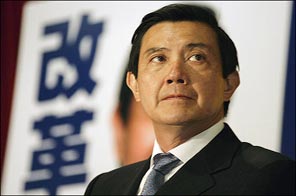Taiwan prez criticized for typhoon
CISHAN: Taiwanese President Ma Ying-jeou sharply raised the expected death toll from Typhoon Morakot on Friday to more than 500, amid mounting criticism of his handling of the worst storm to strike the island in over 50 years.
Ma gave the new estimate to a national security conference, the first called since he took office 15 months ago.
It dramatically raised the previous toll by concluding that 380 of about 600 people living in the mountainous village of Shiao Lin in southern Taiwan perished when flash flooding unleashed calamitous mudslides that buried the community early Sunday.
"The estimated death toll so far has been 120 people," the president told the conference. "In addition about 380 people died in Shiao Lin, so the total death toll will exceed 500."
National security conferences are only held when Taiwan faces extremely serious disasters or grave situations in defense or diplomatic affairs.
Criticism of Ma's handling of the Morakot disaster is rising quickly — even within Ma's own party and in media outlets normally friendly to the president.
Much of the criticism focused on comments he made Thursday to Britain's Independent Television News in which he appeared to blame Morakot victims for their own fate.
"They were not fully prepared. If they were, they should have been evacuated much earlier," Ma told an ITN reporter. "They didn't realize how serious the disaster was."
Taiwan's normally pro-Ma China Times newspaper lambasted the president for the remarks, saying they were badly out of place.
"It is not presidential to tell international media that the blame falls on people who would not evacuate in order to safeguard their own homes," the newspaper said.
Ma also has come under fire for his handling of government efforts to save storm victims and help the island's hard-hit south recover.
"If we expect the people to do everything themselves, what do we need a government for?" chided lawmaker Lo Shu-lei of Ma's ruling Nationalist Party. Ma "seems to be out of the loop and doesn't understand the way the relief system works," she said.
The criticism of Ma is reminiscent of the hostile reaction to former President George W. Bush's handling of Hurricane Katrina in 2005 — criticism that played a major role in turning public opinion against the U.S. leader.
It is significant because Ma has embarked on an aggressive campaign to improve relations with rival China, from which Taiwan split amid civil war in 1949. While most people still back the reconciliation efforts, support is slipping amid opposition claims that they are making Taiwan economically dependent on the mainland and undermining its de facto independence.
Should the impression be created that Ma failed badly in responding to the Morakot challenge, support for his China initiative could falter further as more people question his overall leadership ability.
For its part, China is preparing to send additional storm assistance to Taiwan, the official Xinhua News Agency said, without giving details. In addition, the Chinese Red Cross Society, an official Buddhist association, and five leading Chinese companies have offered another 25 million yuan ($3.5 million) in cash for Taiwan relief work.
Taiwan's own rescue efforts continued with emotional scenes at Cishan Junior High School, a focal point of relief operations.
As a helicopter bearing storm survivors landed Friday at the school's improvised landing zone, anxious friends and relatives pressed forward, hoping their loved ones had finally been brought to safety.
There was joy for some, sadness for others.
"We have been waiting here for a week," said Hsieh Hsien-hui of Mei Lan village, after seeing her parents disembark from an arriving helicopter. "When we saw them coming, we were overjoyed."
Morakot dumped more than 80 inches (two meters) of rain on the island last weekend and stranded thousands in villages in the mountainous south. A total of 15,400 villagers have been ferried to safety, and rescuers are working to save another 1,900 people. The storm destroyed the homes of 7,000 people and caused agricultural and property damage in excess of 50 billion New Taiwan dollars ($1.5 billion), Ma told the security conference.
Rescuers have relied on helicopters to reach the worst-hit areas, and on Thursday authorities requested larger choppers from foreign governments capable of carrying earth-moving equipment and shelters.
Many villagers have conducted their own rescue operations. More than 20,000 troops have joined civilian workers in rescue, cleanup and rehabilitation work, officials said.






